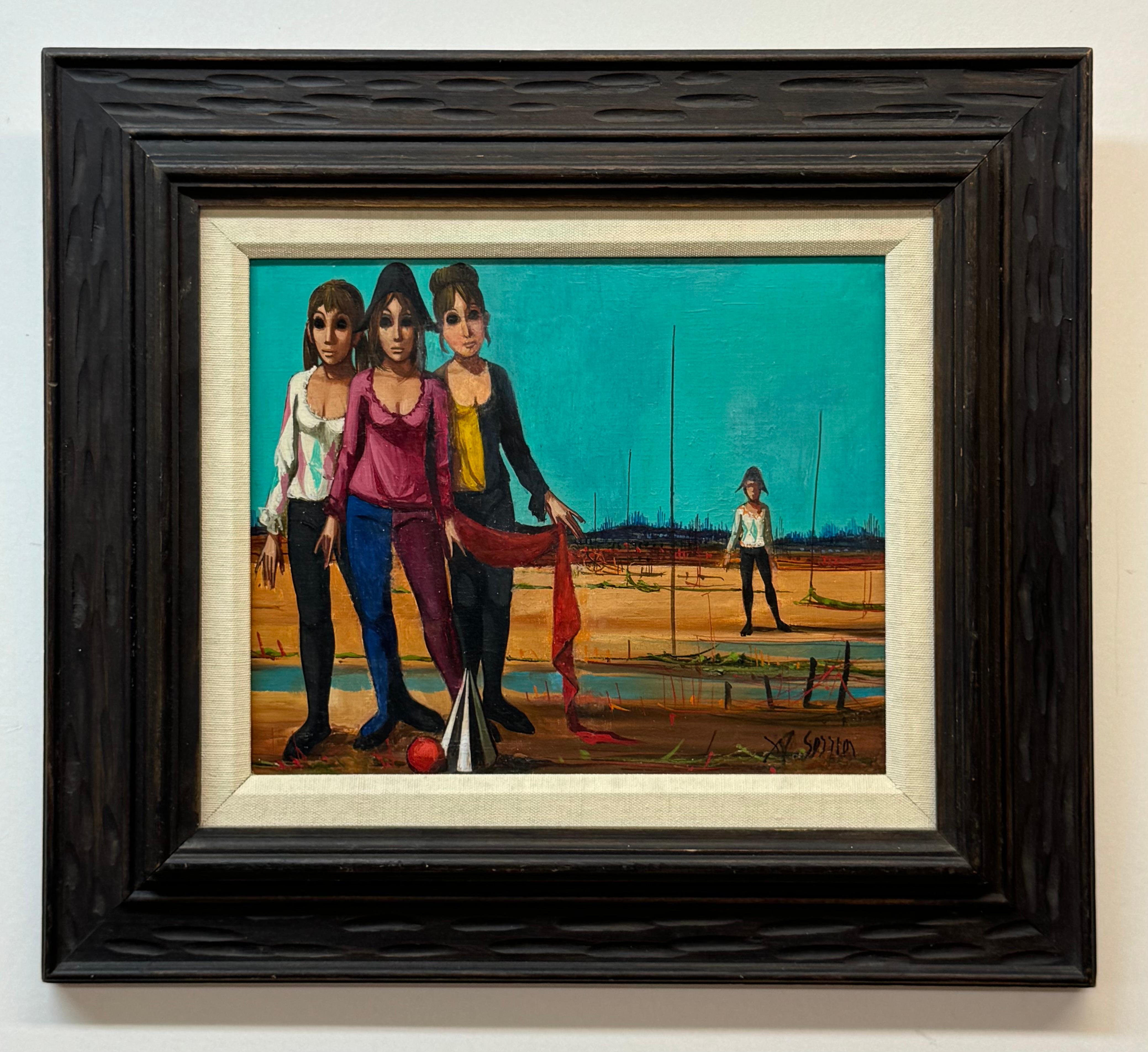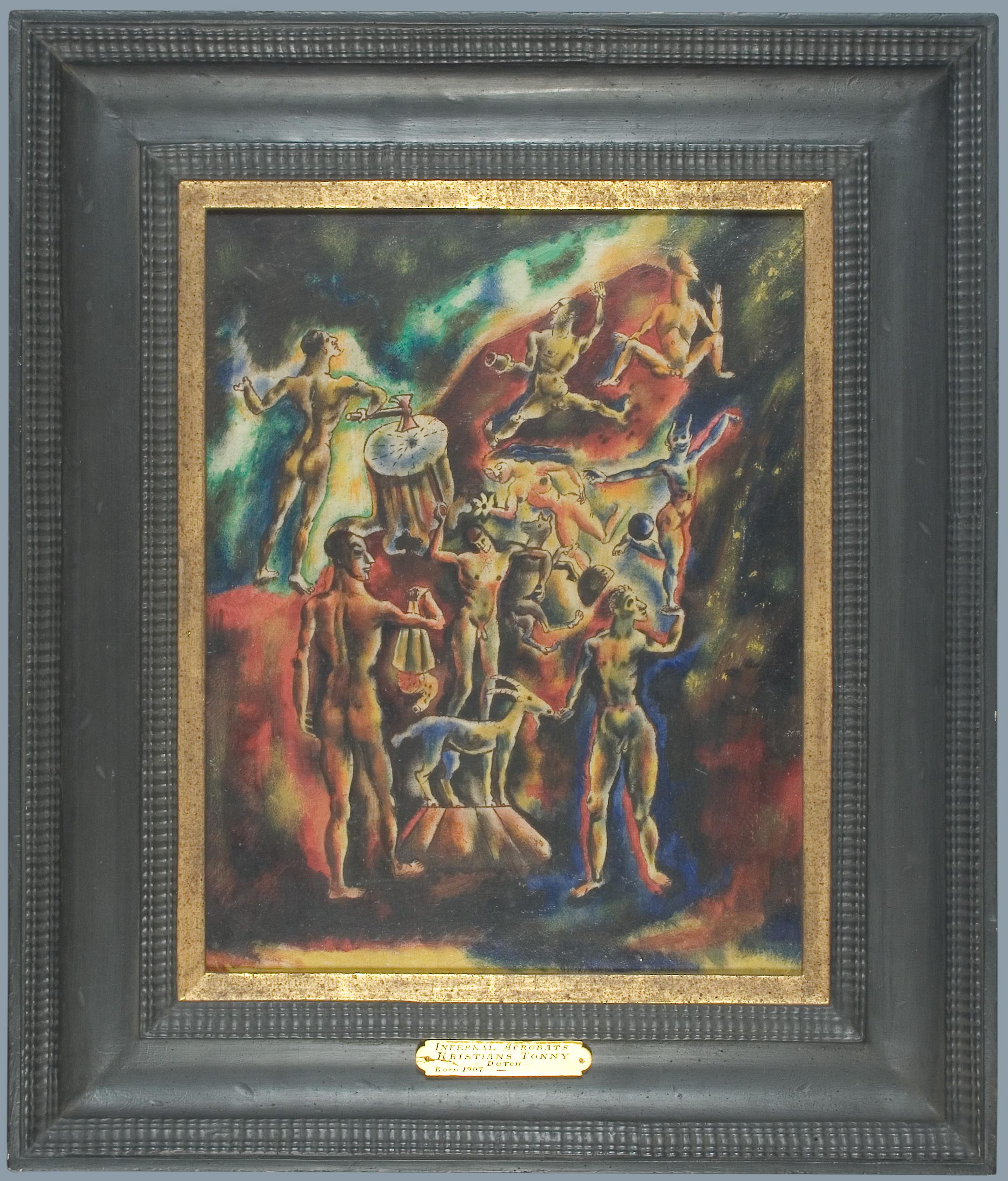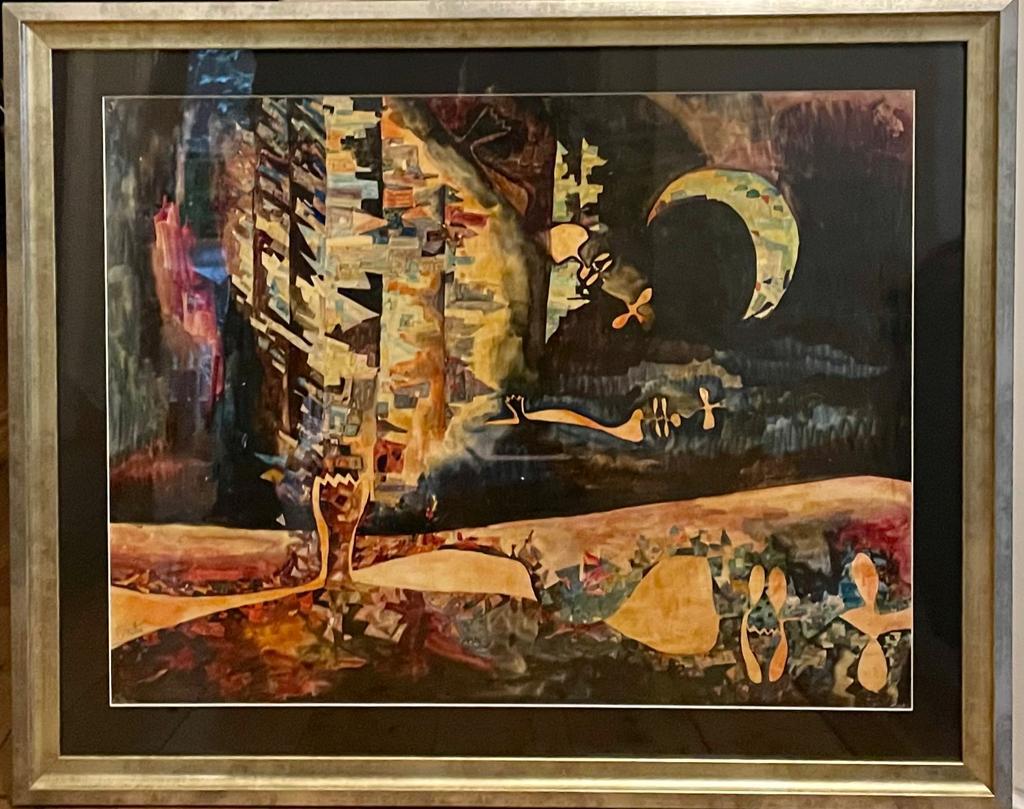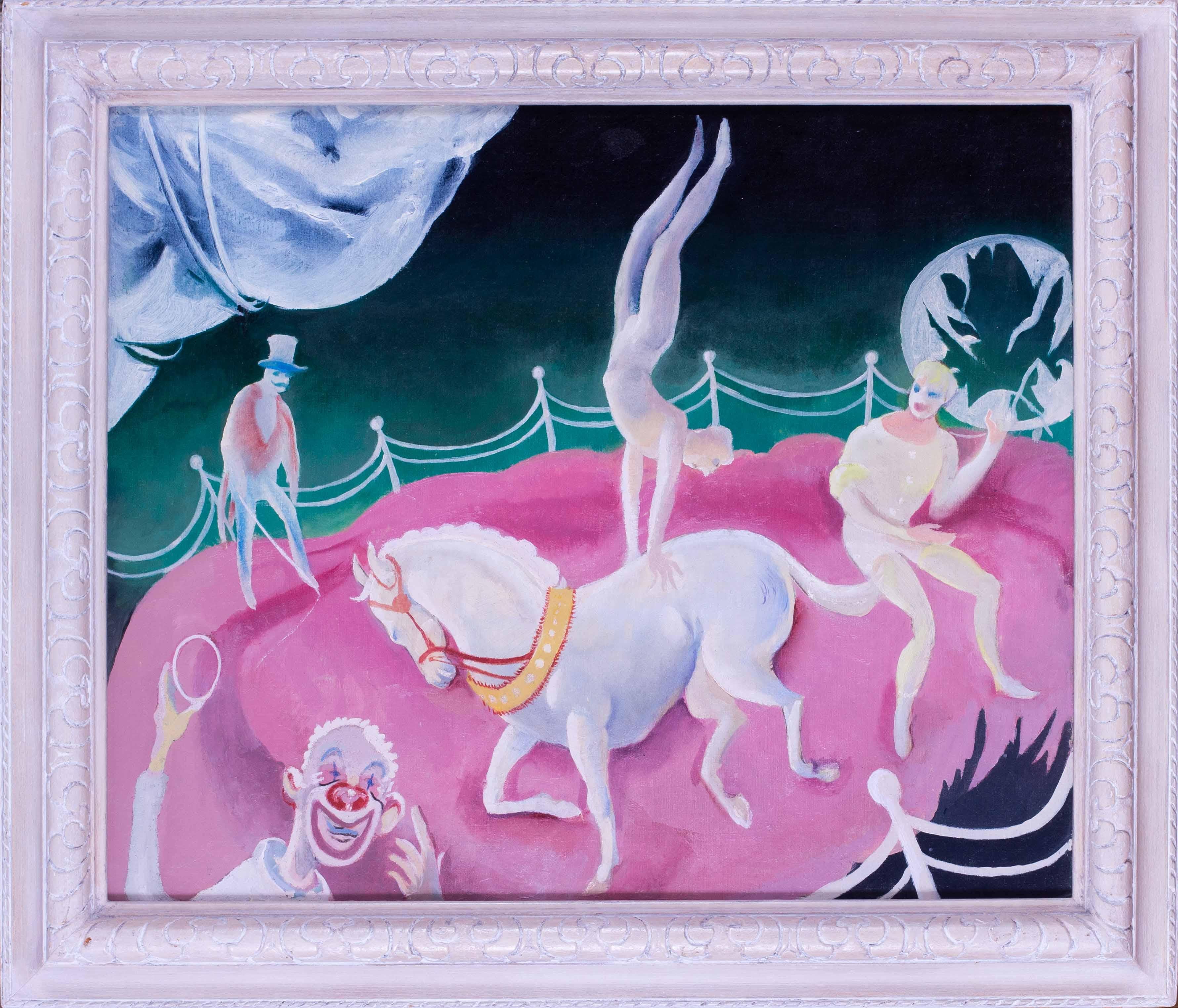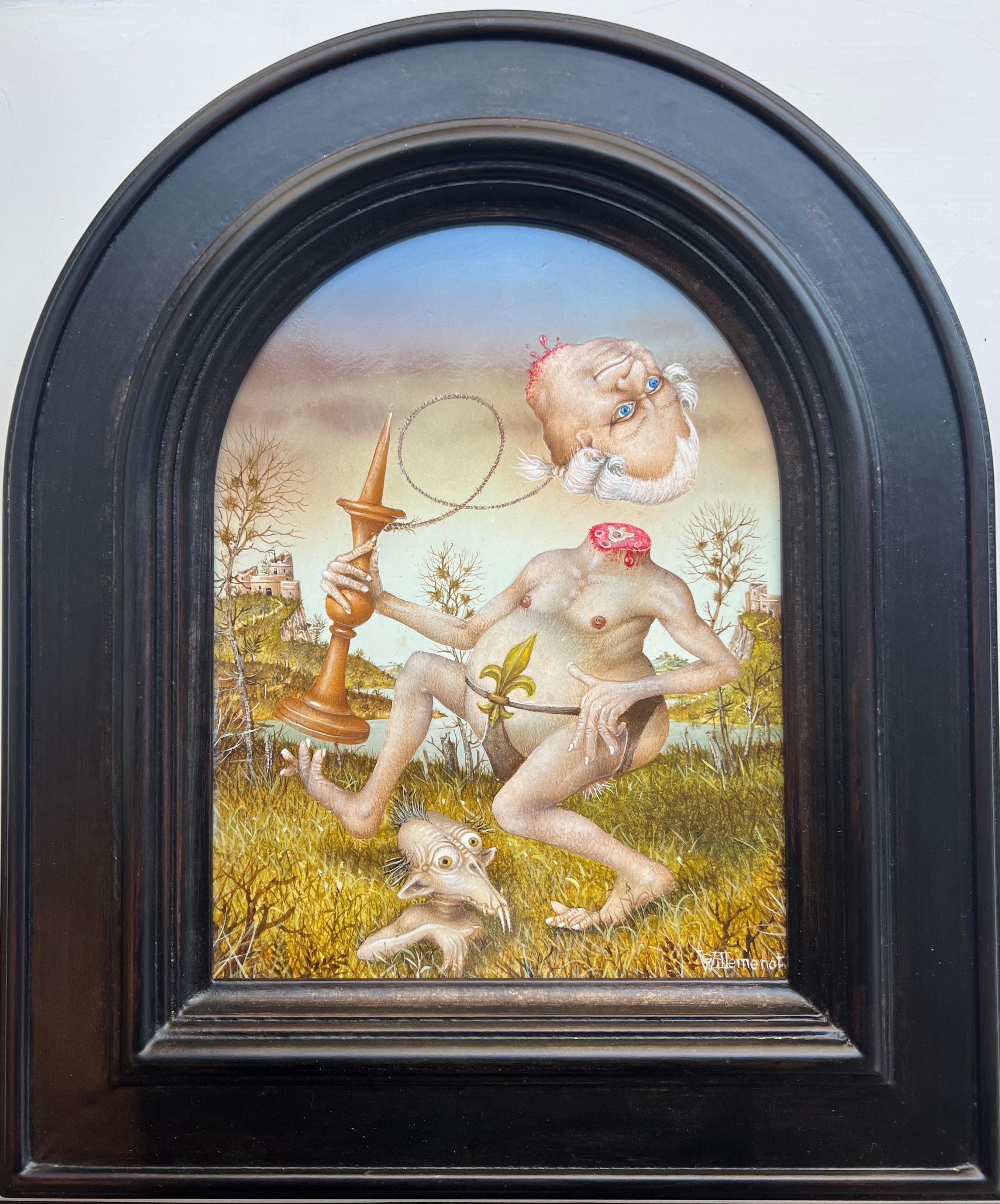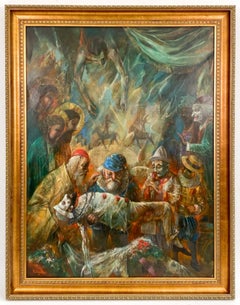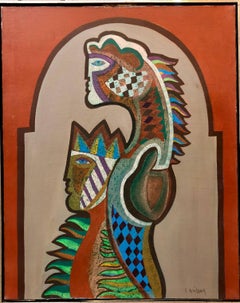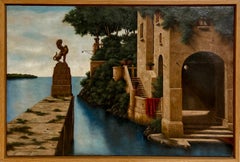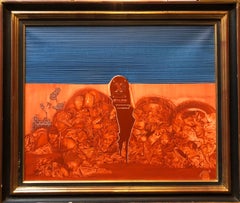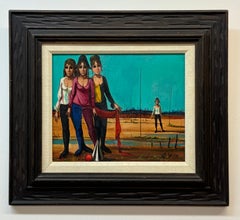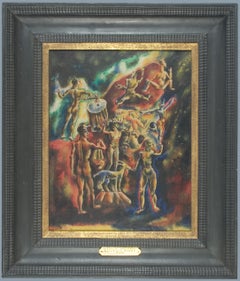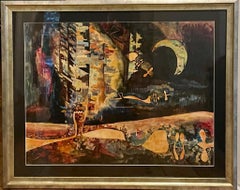Items Similar to French Mod Surrealist Commedia dell'arte Circus Scene Oil Painting J.P. Serrier
Want more images or videos?
Request additional images or videos from the seller
1 of 14
Jean Pierre SerrierFrench Mod Surrealist Commedia dell'arte Circus Scene Oil Painting J.P. Serrierc.1950's-1960's
c.1950's-1960's
$3,600
£2,714.76
€3,139.75
CA$5,050.78
A$5,614.26
CHF 2,942.87
MX$68,563.66
NOK 36,740.07
SEK 34,565.55
DKK 23,434.16
About the Item
Jean Pierre Serrier (French, 1934-1989)
Oil on canvas painting depicting four figures
Hand signed lower right.
Measures (frame) 26.5" x 30" wide, and (sight) 18.25." x 22.25" wide.
Jean Pierre Serrier (1934 – 1989) was a French painter known for surrealism and absurdist art. Jean-Pierre Serrier was born in Montparnasse, Paris and attended the Académie des Beaux-Arts in Paris.
the son of Louis and Solange Serrier. His father fought in World War II and became a prisoner of war. In 1940, as a six-year-old, he and his mother fled Paris for Corrèze in southwest France. Childhood memories of close escapes from German bombardments would later influence his absurdist philosophy of life. Passionate about drawing, in 1951 he applied and was admitted to the École nationale supérieure des arts appliqués et des métiers d'art in Paris. He shared an attic apartment in the 16th arrondissement with fellow student Jean-Baptiste Valadié. For income, he decorated shop windows. A trip to Spain provided motifs for early works. His student work might be characterized as art naïf (Naive art). While still a student, he sold a ceramic artwork to the poet and publisher Pierre Seghers, who would later commission drawings from him. He frequented jazz clubs in Saint-Germain des Près, and while listening to Sidney Bechet at the Vieux Colombier, he met his wife, Yvette.One of the last French Surrealist and follower of Nietzsche. His art conveyed the message to all of mankind that we are only human. The other Surrealist to center his art in philosophy was Rene Magritte whose paintings reflect his understanding of Sigmund Freud. He had his first exhibition in 1955, before being sent to Algeria to complete his military service. After graduating in 1955, he was drafted for military service, spent time in Germany and Morocco, and was sent to the front lines of the Algerian War. In 1959 he exhibited works at two Parisian galleries and at Juan-les-Pins on the Côte d'Azur. From 1961, he exhibited annually at the Salon des Artistes Français. In 1962, the City of Paris purchased his painting Un dimanche In 1961, Serrier made his first visit to the United States to exhibit at a New York gallery. In 1975 and 1979, he had successful exhibitions in New Orleans, and his work was included in art and news magazines, including Time and Newsweek.
Beginning in the 1950s, his works included stylized portraits similar in some ways to the "big eyes" art of Margaret Keane, though it is uncertain that either artist influenced the other. Keane painted children, and so did Serrier, sometimes from life, but Serrier’s models are usually somewhat older, though uniformly slender and with androgynous features.
A gallery owner introduced Serrier to American collectors Edgar Garbisch and his wife, Bernice Chrysler (daughter of Chrysler founder Walter P. Chrysler), who had a particular interest in naïve art; they commissioned a series of portraits from Serrier. At the same time, he met Reine Ausset in Paris, who in 1961 invited him to New York to take part in an exhibition at Galerie Norval on 57th Street. The show also included work by Moïse Kisling, and the exhibition program explicitly linked the two artists, saying that Serrier, who considered Moise Kisling "the Master," had found his own technique, but "the same vision joins the grand Kisling to the young Serrier: plenitude of shapes, sureness of palette, precision in outlines."
In the 1960s he began painting slender, young, androgynous figures in groups, set in sparse landscapes with suggestions of the surreal and sometimes wearing costumes of the Commedia dell'arte. In some of these paintings the eyes of the figures are completely black, a motif that would continue in his later work. In 1965, he exhibited at Forest and Reed Gallery in London. Also in 1965, he discovered the small town of Martel, and with his old roommate Jean-Baptiste Valadié purchased a house that they opened as the gallery La Licorne (The Unicorn) in 1967.
Responding to the political upheavals of May 1968 in France, and following the advice of Geneva gallery owner Roger Ferrero, Serrier's work became increasingly complex, idiosyncratic, and surreal. Imagery included the Tower of Babel, bodies suspended in space, and crowds of people all dressed alike, with identical features and entirely black eyes. Mannequins, playing cards, nudes, and levitating orbs also figured in the work. In a nod to Magritte, his men sometimes wear bowler hats. Another influence may have been the works of the Franco-Belgian surrealist Gaston Bogaert (1918-2008). Serrier's first major exhibit of these works, in Geneva in 1971, was titled Le Réalisme Fantastique. (Magic Realism)
In 1972, he was made a member of the Société du Salon d'Automne, under whose auspices he was invited by the Polish government to exhibit in Warsaw in 1973, as part of a cultural exchange across the Iron Curtain. In 1976, he served on the jury of the Salon d'Automne.
In 1975, New Orleans gallery owner Kurt E. Schon brought his work to several cities in the United States. A copiously illustrated monograph in English, Surrealism and the Absurd: Jean Pierre Serrier, was published in 1977. Author Thomas M. Bayer wrote: Serrier's world is one where—to use Friedrich Nietzche's term—the "human herd animal" is being confronted with the overwhelming task of coping with the world, his solitude, and at times, his resignation in the face of its monstrous size and duration. It is a world where the characterless, "blind" man faces the institutions, rules and symbols that made him into the being he now is…But Serrier does not lose himself in this world he portrays. He never forgets the old French tradition, the "black" humor, à la Molière. This classical humor at times is more felt than seen, in a manner that can be terribly funny, because it is horrifying, laughable, poignant and always true. Serrier told a friend, "In each of my paintings there's a message of hope amid the crowd of stereotypical figures. It could be an escaping dirigible, or a nymphet who flees like a deer under the red and blue trees of paradise."
In 1986, Schon mounted The First Major Retrospective Exhibition of Works by French Surrealist Jean Pierre Serrier in New York. The venue was Automation House, a "center for working out problems caused by automation, and for developing and displaying technological art."
In 1989, at the age of 54, Serrier died. His last works were exhibited that year at the Salon d'Angers and at Galerie Ferrero in Geneva.
The journalist Marie-France Coquard remembered him as "the most generous and faithful friend one could imagine. He forgave everything without passing judgment, often giving more than he received…Jean Pierre gave away, beyond counting, lithographs, artist's proofs…drawings, paintings, his own as well as those of his colleagues. And he did so just as you might give a flower from your garden to a friend who has come to visit." In 2017, the Musée de Montmartre hosted the program Jean Pierre Serrier, Peintre surréaliste montmartrois.
His works in museums include:
The Shoot Gallery (1968) at the Canton Museum of Art in Ohio.
L'Autre Côté du Mur (The Other Side of the Wall) at the Arnot Art Museum in Elmira, New York; exhibited in the show The Surreal in 2021.
A 21st-century auction record for a work by Serrier was set by Course de Vélo (1973), sold for $8125 (including premium) at Neal in New Orleans in 2022.
He was a member of the Autumn Salon and in 1976 was elected a jury member. He exhibited widely during his lifetime, including in London, Paris, Geneva, and Brussels, and posthumous retrospectives of his work took place in New York and New Orleans.
- Creator:Jean Pierre Serrier (1934 - 1989, French)
- Creation Year:c.1950's-1960's
- Dimensions:Height: 26.5 in (67.31 cm)Width: 30 in (76.2 cm)
- Medium:
- Movement & Style:
- Period:
- Condition:
- Gallery Location:Surfside, FL
- Reference Number:1stDibs: LU38213653462
About the Seller
4.9
Platinum Seller
Premium sellers with a 4.7+ rating and 24-hour response times
Established in 1995
1stDibs seller since 2014
1,799 sales on 1stDibs
Typical response time: <1 hour
- ShippingRetrieving quote...Shipping from: Surfside, FL
- Return Policy
Authenticity Guarantee
In the unlikely event there’s an issue with an item’s authenticity, contact us within 1 year for a full refund. DetailsMoney-Back Guarantee
If your item is not as described, is damaged in transit, or does not arrive, contact us within 7 days for a full refund. Details24-Hour Cancellation
You have a 24-hour grace period in which to reconsider your purchase, with no questions asked.Vetted Professional Sellers
Our world-class sellers must adhere to strict standards for service and quality, maintaining the integrity of our listings.Price-Match Guarantee
If you find that a seller listed the same item for a lower price elsewhere, we’ll match it.Trusted Global Delivery
Our best-in-class carrier network provides specialized shipping options worldwide, including custom delivery.More From This Seller
View AllLarge Oil Painting Circus Scene Clowns Rediscovered NY Artist Jonah Kinigstein
By Jonah Kinigstein
Located in Surfside, FL
Jonah Kinigstein
"Death of a Clown"
Large Oil on Board Painting of macabre circus scene with clowns
Hand signed lower left and signed and titled verso
Frame: 55 X 43 Image: 48 X 36
...
Category
20th Century Expressionist Portrait Paintings
Materials
Oil, Board
Surrealist Woman Oil painting French-Moroccan Israeli Bezalel School Painter
By Simon Avissar
Located in Surfside, FL
Two Women. Colorful Surrealist Portrait
Genre: Surrealism
Subject: woman
Medium: Oil
Surface: Canvas
Country: Israel
Simon Avissar, painter, born 1948, Morocco. Moved to U.S.A. Wo...
Category
20th Century Surrealist Figurative Paintings
Materials
Canvas, Oil
Surrealist Oil Painting Magical Realism Lionel Kalish Italian Home Fantasy Scene
Located in Surfside, FL
Lionel Kalish (American B.1931)
"A Villa on the Sea",
c. 1980
Oil on canvas
Hand signed lower right L.Kalish
Bark Frameworks Inc. N.Y. label verso
16" x 24"
Lionel Kalish born...
Category
1980s Surrealist Landscape Paintings
Materials
Oil, Canvas
Untitled, Nude Surreal Figures Together Slovenian French Oil Painting
By Heinrich Maryan Frama
Located in Surfside, FL
Genre: Surrealism
Subject: Abstract
Medium: Oil
Surface: Canvas
Country: France
In this surreal composition by Heinrich M. Frama the artist clumps a group of figures towards the mid...
Category
20th Century Surrealist Figurative Paintings
Materials
Canvas, Oil
French Neo Expressionist Surreal Oil Painting Robert Vernet Bonfort Deaf Artist
By Robert Vernet-Bonfort
Located in Surfside, FL
Robert Vernet-Bonfort (French, 1934-2017)
LA VIEILLE MAISON
Oil painting on canvas
Hand signed lower right, signed and inscribed on verso
In a heavy carved frame
Dimensions: 19 ¼ x ...
Category
20th Century Neo-Expressionist Landscape Paintings
Materials
Canvas, Oil
Mid Century Hungarian Gilt Oil Painting on Board Modern Judaica
Located in Surfside, FL
From a collection by a long time Miami Beach art dealer on the old Lincoln Rd. This is a piece he brought back from hungary. from a collection of good Hungarian artists and Illustrat...
Category
20th Century Modern Figurative Paintings
Materials
Oil, Board
You May Also Like
Jean Pierre Serrier (1934 - 1989, French) Surrealist Circus Scene
By Jean Pierre Serrier
Located in San Francisco, CA
Jean Pierre Serrier (1934-1989, French) Surrealist Circus Scene
Oil on canvas
Signed lower right
Frame: 16.5" W x 14.75" H
Canvas: 10.5" W x 8.75" H
Jean-Pierre Serrier was born i...
Category
Late 20th Century Surrealist Figurative Paintings
Materials
Canvas, Oil
French Neo-Romantic Surrealist Painting "Circus" by Kristians Tonny
Located in Philadelphia, PA
Kristians Tonny
(French, born Holland; 1907-1977)
Circus
Oil on prepared board, 16 1/2 x 13 inches
Framed: 22 x 19 inches (approx.)
Inscribed on reverse: (in pencil) "cadre noir/ave...
Category
1920s Surrealist Abstract Paintings
Materials
Oil, Board
Clownesse, Surrealist Oil Painting by Philippe Alfieri
By Philippe Alfieri
Located in Long Island City, NY
Artist: Philippe Alfieri, Italian/American (1921 - 2009)
Title: Clownesse
Year: circa 1970
Medium: Oil on Canvas, signed l.l.
Size: 30 x 24 in. (76.2 x 60.96 cm)
Frame Size: 38 x 32 ...
Category
1970s Modern Figurative Paintings
Materials
Oil
Surrealist Oil Painting By Fernand Carette, 20th Century
Located in Hoddesdon, GB
Fernand Carette 1921- 2005 Futuristic surrealist landscape . oil painting by Belgian artist Carette painted during the 1960s while he was working with the Phases group . 64cm x 49cm ...
Category
1960s Surrealist Abstract Paintings
Materials
Oil
Circus performance, oil on canvas by French / hungarian artist Marcel Vertes
By Marcel Vertès
Located in Petworth, West Sussex
Marcel Vertes (French/Hungarian, 1895 – 1961)
‘Circus performance’
Oil on canvas board
Signed `VERTES` (to the reverse)
20 x 24 in. (51 x 61 cm.)
Provenance: With the Hammer Gallerie...
Category
20th Century Modern Figurative Paintings
Materials
Canvas, Oil
Louis XVI jouant apres la Revolution Tempera on Panel Surrealism in Stock
By Gérard Willemenot
Located in Utrecht, NL
Louis XVI jouant apres la Revolution Tempera on Panel Surrealism in Stock. Sizes including frame. Size without frame 24 x 18 cm
Gérard Willemenot (1943, Paris, France) graduated as ...
Category
21st Century and Contemporary Contemporary Figurative Paintings
Materials
Tempera, Panel
More Ways To Browse
French Military Paintings
C M Young
Paris Scenes By Pierre
1960s Spanish Painting
French Mannequin
Algeria Painting
Set Of Four Oil Paintings
P English Artist
Mid Century Painting French City Scene
P Forest
Paris Scene Oil Painting 1950
Moroccan Oil Painting
Oil Painting Morocco
P English Paintings
Figurative Surrealist Mid Century
Surrealist Dress
J Street Vintage
A J Bayer
